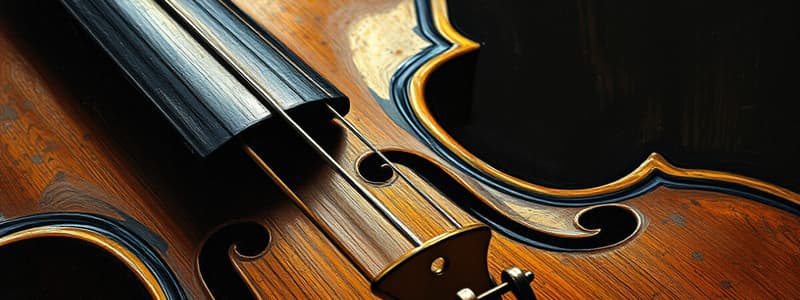Podcast
Questions and Answers
The top of the neck is called the ______.
The top of the neck is called the ______.
Scroll
The part used to tighten and loosen the strings is the ______.
The part used to tighten and loosen the strings is the ______.
Tuning Pegs
The small piece of material that helps the strings stay in place is the ______.
The small piece of material that helps the strings stay in place is the ______.
Nut
The narrowest part of the violin's body is known as the ______.
The narrowest part of the violin's body is known as the ______.
The part that secures the strings is called the ______.
The part that secures the strings is called the ______.
The two holes on the violin's body are referred to as ______.
The two holes on the violin's body are referred to as ______.
Flashcards are hidden until you start studying
Study Notes
Parts of a Violin
- Scroll: Located at the top of the neck, provides aesthetic appeal and houses the tuning pegs.
- Tuning Pegs: Used for adjusting string tension; critical for maintaining correct pitch.
- Nut: A small component that keeps strings aligned and at a proper height from the fingerboard.
- Neck: Long wooden structure where the fingerboard is attached, allowing for finger placements while playing.
- Strings: Four strings tuned to G, D, A, and E, essential for producing sound; vibration creates music.
- Upper Bout: The upper curved section of the body, contributing to the violin's shape and acoustics.
- Fingerboard: A smooth wood strip under which the player presses to change string pitch; vital for note production.
- F Holes: Two sound holes on the body that enhance sound projection; shaped like the letter "f."
- Bridge: A curved wooden piece that elevates the strings above the body, transmitting vibrations to the instrument.
- Fine Tuners: Adjustments made for precise tuning of strings, typically found on the tailpiece.
- Chinrest: An ergonomic addition allowing the player to comfortably hold the violin against their neck.
- Waist: The narrowest area of the violin's body that aids in balance and ergonomics during play.
- Lower Bout: The lower curved section of the body, balancing the upper bout and contributing to overall sound quality.
- Tailpiece: Secures the strings at the bottom of the violin and houses the fine tuners.
- Pegbox: The section of the neck that contains the tuning pegs; essential for string adjustment and tuning.
Studying That Suits You
Use AI to generate personalized quizzes and flashcards to suit your learning preferences.




